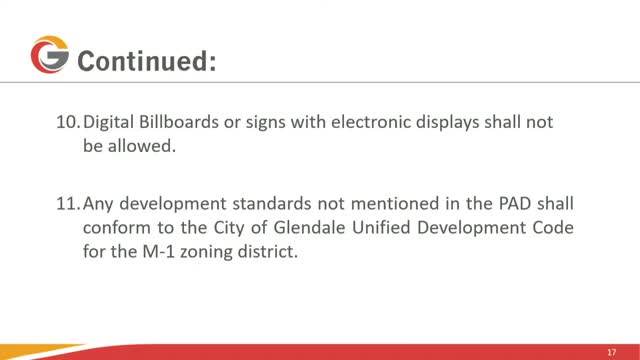Residents voice fierce opposition to Glendale development plans
September 27, 2024 | Glendale, Maricopa County, Arizona
This article was created by AI summarizing key points discussed. AI makes mistakes, so for full details and context, please refer to the video of the full meeting. Please report any errors so we can fix them. Report an error »

During a recent government commission meeting, discussions centered on a proposed development project in Glendale, Arizona, which has sparked concerns among local residents regarding traffic and environmental impacts.
The meeting began with a presentation outlining stipulation number five, which requires the developer to coordinate with local entities on shared access to a private drive along Reams Road. The stipulation is part of a broader set of requirements being transferred from a previous project, CRO 303, which has yet to be developed. The commission noted that traffic assessments would be revisited once the CRO 303 project is underway.
Developer Taylor Earl presented a plan to incorporate a small parcel of land into the existing Planned Area Development (PAD). This addition is intended to enhance parking facilities, which Earl argued would make the site more marketable and beneficial for Glendale. He emphasized that the project is progressing through the design review process and is largely straightforward.
However, the meeting took a turn when local resident Laura Curtis voiced her strong opposition to the ongoing development in the area. Curtis expressed frustration over the increasing truck traffic and the encroachment of industrial developments into her residential community. She highlighted the negative effects of construction on local roads, increased heat from urbanization, and the potential decrease in property values. Curtis passionately requested that the commission refrain from any annexation efforts, asserting that the community had previously rejected such measures.
The commission acknowledged Curtis's concerns but clarified that their role did not include decisions on annexation. The public hearing concluded without further comments from the audience, but the sentiments expressed by Curtis reflect a growing tension between development initiatives and community preservation in Glendale.
The meeting began with a presentation outlining stipulation number five, which requires the developer to coordinate with local entities on shared access to a private drive along Reams Road. The stipulation is part of a broader set of requirements being transferred from a previous project, CRO 303, which has yet to be developed. The commission noted that traffic assessments would be revisited once the CRO 303 project is underway.
Developer Taylor Earl presented a plan to incorporate a small parcel of land into the existing Planned Area Development (PAD). This addition is intended to enhance parking facilities, which Earl argued would make the site more marketable and beneficial for Glendale. He emphasized that the project is progressing through the design review process and is largely straightforward.
However, the meeting took a turn when local resident Laura Curtis voiced her strong opposition to the ongoing development in the area. Curtis expressed frustration over the increasing truck traffic and the encroachment of industrial developments into her residential community. She highlighted the negative effects of construction on local roads, increased heat from urbanization, and the potential decrease in property values. Curtis passionately requested that the commission refrain from any annexation efforts, asserting that the community had previously rejected such measures.
The commission acknowledged Curtis's concerns but clarified that their role did not include decisions on annexation. The public hearing concluded without further comments from the audience, but the sentiments expressed by Curtis reflect a growing tension between development initiatives and community preservation in Glendale.
View full meeting
This article is based on a recent meeting—watch the full video and explore the complete transcript for deeper insights into the discussion.
View full meeting
